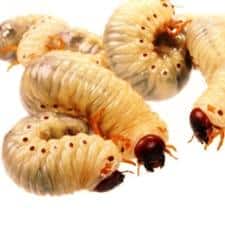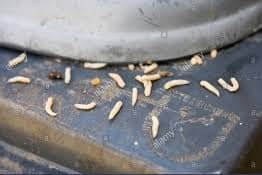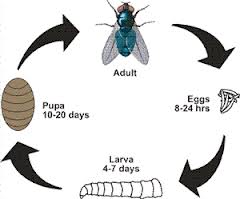Flies belong to the order “Diptera” and undergo complete metamorphosis like other insects which means they look different from their “young” versions. In this article, you’ll learn the different stages of flies.
So, what does a baby fly look like?
A baby fly resembles small worms that are pale or creamy white in color, they are called fly larvae or “maggots”. Maggots are half an inch in length and they are legless, wingless insects that crawl around searching for food.

A bunch of baby flies can be easily spotted, due to their endless “wriggling” around on the ground.
Baby flies hatch from fly eggs that are often laid in multiple batches. This is why you often find a lot of white colored small worms wriggling around in one place.
Majority of fly species have the same appearance as babies (maggots).
However, as insects that undergo metamorphosis, their appearance as fly babies will completely change as soon as they reach the next stage of their life cycle.
Baby flies only stay as baby flies (maggots) for five to eight days.
Are you looking for how to get rid of Flies or get rid of maggots?
During that time frame, they have to eat as much food as they can. The food they will consume will be stored as energy.
Baby flies need enough energy in order to enter the next stage of their life cycle, to become a pupa.
Fly pupa resemble caterpillars inside their cocoons. It is often dark in color and still small in size. They will remain still inside as pupa for a couple of days and slowly undergo a transformation into full grown flies.
What do baby flies eat
Knowing what they look like, you might be curious about what baby flies eat. Maggots, or baby flies, have a wide range of diet.
Maggots eat waste, overripe fruit and vegetables, meat, other leftover food, fermented substances, decaying carcasses and sometimes plants too. For extreme cases, they will consume tissues of living human beings as well when an infestation is taking place.
Similar to its parents, the flies, maggots eat literally almost anything in order to survive.
As mentioned above, maggots stay as larvae (worms) for five days and they need eat as much as they can during that time frame so they can enter their pupation stage.
If they are unable to find enough food sources, they could extend their stay as maggots for up to eight days.
Without eating, maggots can only last for up to two to three days. They will not be able to survive and reach the next stage of a maggot or a fly’s life cycle.
However, given that maggots have multiple choices for food consumption since they are not picky eaters, maggots often survive and that is how flies keep up with their numbers.
What do fly eggs look like
Now that we are talking about how baby flies look, you should also know how they look like while they are still inside their eggs.

A baby fly egg usually resembles a grain of rice and usually colored gray. The egg size is usually around 4 to 7.5 millimeters long.
The average fly can lay up to four or six batches of 75 to 100 eggs and it normally hatches after 12 to 24 hours.
Where flies lay their eggs
Flies often lay their eggs in almost any warm, moist material that will provide food for the larvae or maggots.
- 6 Common Places Where Flies Lay Eggs
- Garbage Bins
- Feces, Animal Wastes
- Plants, Bird Nests, Animal Nests
- Decaying Corpses, Carcasses, Dead Animals
- Liquid Substances, near sources of water
- Unattended Food, Spoiled Food, Rotten Food
There are also times when flies would lay eggs on other areas. They could lay eggs in areas with warmer temperatures or places that have light sources and places that have been infested by other insects.
Flies prioritize laying their eggs in places where maggots can feed on instantly, the moment the maggots or larvae will emerge from the eggs.
The thing with flies is that they eat almost anything, making them capable of laying eggs on every consumable material for them.
How long do baby flies live
Baby flies (maggots), can only live for up to three to five days without food or water.
Here’s the life cycle of flies – to learn more about baby flies.
What is the life cycle of a baby fly
There are only “three” stages from the life cycle of flies, baby flies or maggots. The beginning of maggots mark the beginning of their transformation into adult flies.

- Larvae stage
- Staying as a larvae
- Preparing for pupation
- Pupation stage
- Slow transformation
- Adult fly stage
- Repeat the cycle
1. Larvae stage
Before entering the pupation stage, maggots actually undergo through multiple molting periods which is necessary to attain new forms before taking on a “new level” which is becoming a pupa.
How long baby flies stay as larvae
Maggots stay in their larvae stage for as long as five to ten days.
When the maggot is born, their first priority is eating in order to store as much energy as possible to get ready for pupation, the stage where they transform into adult flies from pupa.
Normally, maggots need to eat for three to five days but it can be longer than that if they are having difficulty finding food. It happens when they are born in a place where the food is not enough for hundreds of maggots.
Where baby flies go to enter pupation
Once the maggot has already stored enough energy to enter the pupation stage, they will now look for a dark, secluded place that can secure their safety. Usually, a maggot pupa can be found underneath garbage bins or dark unattended corners.
2. Pupation stage
After finding a safe place away from predators, the maggot will enter and begin the pupation stage after four days. They will then begin their transformation slowly and the process usually takes up to ten days.
As soon as the pupation stage ends, the maggots turned larvae turned pupa can now become adult flies.
3. Adult fly
When the pupation stage ends, the once maggot is now an adult fly that is also ready to lay its own eggs within two days. This will allow their kind to repeat the same process over and over again, keeping their kind going as the world continues to revolve.
Gestation period
Now that the maggots have become adult flies, they are not able to lay their own eggs. A fly stays pregnant for only 24 hours and the egg also hatches after another 24 hours which makes it easy for flies to keep their numbers up.
Repeating the same process, the adult fly will lay its egg on places where the maggots can easily feed off. Usually, they prefer to lay the eggs on decaying corpses because it provides enough food for hundreds of maggots and lasts for days.
How to get rid of baby flies
Now that you can distinguish how baby flies look like, here are five simple ways to get rid of baby flies (maggots).
- Spray maggot repellents
- The most effective way to get rid of maggots including flies and the eggs in the area where they hatched is spraying an insect repellent.
- There are a lot of fly or maggot insecticides that can be purchased from any local store so if you see one, you should immediately buy yourself an insect repellent to get rid of them. It works quickly and all it takes is a few spray and you’re done!
- You just have to make sure that you will also clean the area afterwards to make sure there are no other eggs and keep your garbage bins closed so that no other flies can come back around to lay their eggs on it once again which will cause more maggots and flies.
- Boiling water
- According to research, maggots don’t really drown but spilling boiling water on them can hurt them. So, if you want to get rid of them immediately without having to go to the store to buy repellents, you can try to use boiling water first.
Just make sure that it is really boiling so it will be effective and clean out the area afterwards as it can potentially just make the maggots hide somewhere or go deeper into the area where you can’t see it. Secure the area and make sure it is clean.
- According to research, maggots don’t really drown but spilling boiling water on them can hurt them. So, if you want to get rid of them immediately without having to go to the store to buy repellents, you can try to use boiling water first.
- Sprinkling salt
- Some people claim that sprinkling a good amount of salt on maggots worked for them.
However, there are different kinds of maggots out there which means it may or may not work but it’s definitely worth the try, isn’t it? We need to get rid of those maggots! You can try to drop a few and see the reaction.
If it works on one of the maggots, then you can assume that it might work for the others as well. If it’s not enough, then you can try the boiling water too. You have many options and you should use them as much as you can.
- Some people claim that sprinkling a good amount of salt on maggots worked for them.
- Raise a pet
- Another way you can get rid of those maggots is actually raising an animal that naturally preys on insects like flies and maggots. If you are a fan of amphibian or reptile pets, it’s your time to take advantage of that. Pets like frogs, chameleons, iguanas, lizards and geckos can clear those maggots for you.
Some type of birds also eats maggots and spiders on the other hand also eat and catch those kinds of insects.
One more exotic option for you is the Venus flytrap plant. Although it is a plant, some people like to refer to it as a “pet”. You can feed those maggots to your Venus flytrap plant and they can also catch some of the flies hanging around so the number of eggs turning into maggots will also be lessened.
- Another way you can get rid of those maggots is actually raising an animal that naturally preys on insects like flies and maggots. If you are a fan of amphibian or reptile pets, it’s your time to take advantage of that. Pets like frogs, chameleons, iguanas, lizards and geckos can clear those maggots for you.
- Use force
- Worst comes worst, sometimes we must just use force because we don’t really have a repellent available all of the time or have the energy to boil water and see if the salt method works.
You can try to burn the maggots off or crushing them with a solid object… but we want to avoid being so violent as much as possible… so just buy yourself a repellent!
- Worst comes worst, sometimes we must just use force because we don’t really have a repellent available all of the time or have the energy to boil water and see if the salt method works.
Related Questions
Why do baby flies suddenly appear?
Baby flies (Maggots) suddenly appear because it only takes 24 hours for a fly egg to hatch into maggots. Fly eggs aren’t easily visible to the naked eye, leaving them unnoticed and making it seem as if maggots just popped out of nowhere. But in reality, they’ve been sitting there as eggs for a whole day.
What causes maggots?
Maggots are caused by fly eggs. They are born from flies. Whatever attracts a fly may cause maggots. Here’s a list of things that attracts flies which ends up causing maggots.
- Things that Causes Maggots
- Garbage
- Feces
- Plants
- Carcasses
- Liquid Substances…
